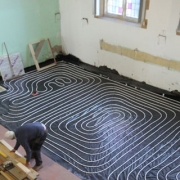A new British invention, following the co-location of Coltraco Ultrasonics’ Physicists and Scientists at Durham University, a globally outstanding centre of teaching and research excellence, the handheld Portascanner® AIRTIGHT 520 is a completely unique technology able to compute air flow and air permeability, quantifying leak sites to complement an airtightness test. Designed during COVID-19 with support from UK Government COVID-19 Emergency Technology Funding and available for exporting globally now, the Portascanner® AIRTIGHT 520 builds on Coltraco’s long history in watertight integrity monitoring for the Royal Navy to deliver the Safeship™ at sea, applying our advanced understanding of fluid dynamics at sea to air flow dynamics to deliver the Safesite™ on land.
The unique ability to detect, locate and quantify air leaks, non-disruptively and without the need for any room pressurisation, in a complementary manner to existing Door Fan and Pulse Airtightness Testing, will enable users of the Portascanner® AIRTIGHT 520 to make sharper decisions, verify technical specifications, and reveal possible defects if design standards have not been met rapidly and reliably.
The Importance of Building Ventilation: Changing Standards in the Built Environment
Professor Catherine Noakes OBE, who sits on the UK Scientific Advisory Group for Emergencies (SAGE) states that “if we do invest as a nation [in ventilation], there’s a potential big win,” with the “long-term payback [of] improved health and productivity, and lower energy use.”
COVID-19 is essentially an indoor air crisis. Whilst vaccinations are a crucially important tactical response, they must be complemented by longer term strategies. To ensure Human Air Hygiene, and safeguard that basic human right, a continuous and assured access to pure, fresh air, every public building must have a Ventilation Strategy.
In its most basic form, the challenge of building ventilation centres around increasing the number of air changes per hour. However, the integrity of air filtration, and or air purification, can only reasonably be assured if all unwanted air infiltration through gaps, is sealed. Air flow measurement devices, such as the Portascanner® AIRTIGHT 520, that allow for frequent and regular detection, location and quantification of unwanted air leaks must therefore be integrated alongside existing airtightness testing equipment, to ensure the success of building ventilation strategies.
In addition to Human Air Hygiene, Fire Suppression, Thermal Comfort, Acoustic Insulation, and Insect and Pest Control are all integral aspects of the Built Environment which require a certain level of airtightness to be maintained, either to deliver the minimum number of air changes per hour, restrict the supply of oxygen to extinguish a fire, or lower energy consumption and waste.
Indeed, in a post-COP26 global environment, addressing the effects of climate change and making buildings more energy efficient and environmentally responsible is driving the construction industry towards “Build Tight Ventilate Right.” Buildings are a significant producer of carbon emissions, accountable for 35% of total energy consumption.
Testing for air leaks and simultaneously testing for watertightness with the Portascanner® AIRTIGHT 520, as water ingress seriously damages buildings and destroys electrical equipment, will improve build qualities, and reduce the costs of operating and maintaining the Built Environment.
The Portascanner® AIRTIGHT 520: Unique Technology to complement Existing Airtightness Testing
During Coltraco Ultrasonics’ long history in watertight integrity monitoring for the Royal Navy they learned that it was one thing to be able to identify large and microscopic leak sites, but that it was quite another to precisely locate and quantify the leak site through the structure concerned to determine the water flow rate. These are the crucial pieces of information required to assess the damage control risk overall in a ship’s watertight compartment, watertight door or watertight Multiple Cable Transit Area between bulkheads.
The Portascanner® AIRTIGHT 520 takes Coltraco Ultrasonics’ understanding of fluid dynamics at sea and applies it to air flow dynamics on land. They take the best ultrasonic technology in Coltraco’s hardware to identify leak sites with a microscopic level of accuracy and apply computer science to measure and quantify the leak-site by the Portascanner® AIRTIGHT 520’s algorithm, which also generates a value for the air flow rate through that leak and the building’s overall air permeability.
The ability to record and analyse these 4 factors makes the Portascanner® AIRTIGHT 520, a British lightweight, hand-held, and portable analytical instrument, a unique technology globally. The Portascanner® AIRTIGHT 520 has been invented to complement existing airtightness testing, typically achieved using a Door Fan Test or a Pulse Test, that is essential for measuring the integrity of the Built Environment.
Integrate Dynamically with Essential Existing Technologies to be Better-Faster-Cheaper: Testing the Portascanner® AIRTIGHT 520 at The Airtightness Testing and Measurement Association’s (ATTMA’s) Building Performance Hub
In January 2022, Coltraco Ultrasonics’ Daniel Dobrowolski (Senior Physicist) and Bernard Hornung (Head of Built Environment) joined Paul Jennings (Airtightness Specialist) and Dr Bill Bordass OBE (Building Scientist) to test the Portascanner® AIRTIGHT 520 in a full-sized house. Testing followed a Pulse Test and a Door Fan Blower Test, both of which the Portascanner® AIRTIGHT 520 is designed to complement.
 The Portascanner® AIRTIGHT 520 performed outstandingly, being able to identify and quantify leaks that had been found with traditional basic methods of leak detection such as thermal cameras, smoke pencils and anemometers, but most importantly finding leaks that could not be found with any alternative method. A significant number of leaks were identified in window and door seals.
The Portascanner® AIRTIGHT 520 performed outstandingly, being able to identify and quantify leaks that had been found with traditional basic methods of leak detection such as thermal cameras, smoke pencils and anemometers, but most importantly finding leaks that could not be found with any alternative method. A significant number of leaks were identified in window and door seals.
The Portascanner® AIRTIGHT 520 allows the ultrasonic quantification of leak sites in a depressurised environment, which has never been achieved before. Door Fan Testing or Pulse Testing can then be conducted at an appropriate moment, once detected leakage points have been identified and repaired. Uniquely, during these tests, the Portascanner® AIRTIGHT 520 allows the location and measurement of air leaks, facilitating remedial action that is precise, immediate, and often low-cost.
Furthermore, Buildings can be surveyed with a Portascanner® AIRTIGHT 520 before an air tightness test so that they have a better chance of passing and, if a building fails an airtightness test, the diagnosis as to why it has failed could include locating and quantifying air leaks with the Portascanner®.
These capabilities of the Portascanner® AIRTIGHT 520 are even more important when one situates the device within the increased world-wide emphasis on airtightness in the built environment as a result of the dual pressures of COVID-19 and climate change. In the UK, higher standards on airtightness in the Built Environment are being encouraged by institutions such as the Passivhaus Trust, which forms a part of the global Passivhaus movement, and is the UK affiliate of the International Passive House Association.
Passivhaus builds are approximately ten times more airtight than the standard required of new-build domestic dwellings in the UK, meaning special attention must be paid to identify potential leakage areas in the building fabric and offsite-manufactured components during the final stages of construction. There are about 65,000 buildings worldwide which have achieved Passivhaus standards of comfort, health, and low energy consumption, with many more in the planning process.
Being able to use ultrasound to detect, locate, and quantify air leaks, eliminates the need for pressurisation, negative or positive. Therefore, the Portascanner® AIRTIGHT 520 can test building components when they are manufactured, such as windows and doors, which is where most leaks manifest themselves, with the aim to eliminate leaks before installation. During the execution of a build programme, or in the case of offsite construction, during the assembly of building components, building control aimed at assuring a better build quality should include the frequent and periodic use of the Portascanner® AIRTIGHT 520.
Coltraco Ultrasonics’ technologies provide their users with the unprecedented visibility necessary to make sharp decisions and understand opaque issues. Integrating the Portascanner® AIRTIGHT 520 with essential existing Door Fan and Pulse airtightness testing will improve build quality, and reduce the costs of operating and maintaining the Built Environment, by improving Human Air Hygiene, Fire Suppression, Acoustic Insultation, Thermal Comfort, and decreasing water ingress and absenteeism.





 A vital element of the design and construction is to maximise the energy efficiency of the new buildings: Wraptite airtightness membrane, the only self-adhering vapour permeable air barrier certified by the BBA, will form a crucial part of the solution.
A vital element of the design and construction is to maximise the energy efficiency of the new buildings: Wraptite airtightness membrane, the only self-adhering vapour permeable air barrier certified by the BBA, will form a crucial part of the solution.





 Back in 2018, the Government laid out its plans to combat the growing housing crisis in the UK. However, since the pandemic hit, off-site manufacturing’s role has been accelerated to a point where it, in my opinion, needs to be considered essential.
Back in 2018, the Government laid out its plans to combat the growing housing crisis in the UK. However, since the pandemic hit, off-site manufacturing’s role has been accelerated to a point where it, in my opinion, needs to be considered essential.
 Already proving to be a true advocate for British businesses, rather than another apologist for foreign takeovers, the Business Secretary was also patriotically flying the flag for a home grown fusion power project, which promises to be the first commercially viable manifestation of the elusive Holy Grail of clean generation.
Already proving to be a true advocate for British businesses, rather than another apologist for foreign takeovers, the Business Secretary was also patriotically flying the flag for a home grown fusion power project, which promises to be the first commercially viable manifestation of the elusive Holy Grail of clean generation.





